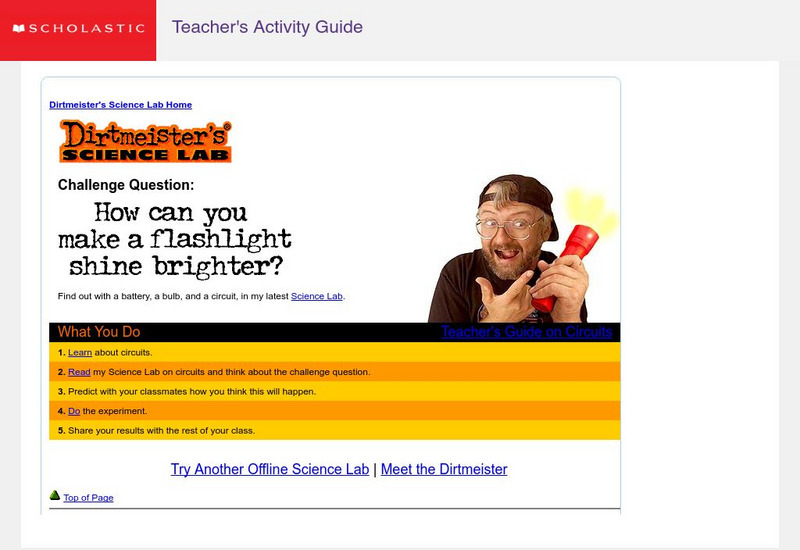Boston University
Elementary Physics: Current and Resistance
A general summary of electrical resistance including a comparison of AC and DC current.
Scholastic
Scholastic: Dirtmeister's Science Lab: Circuits
Step into Dirtmeister's Science Lab as he sets out to answer the challenge question: "How can you make a flashlight shine brigher?" Learn about circuits, make your predictions and then do the experiment.
Science and Mathematics Initiative for Learning Enhancement (SMILE)
Smile: Exploring Series and Parallel Circuits
The Illinois Institute of Technology provides a great classroom activity for exploring series and parallel circuits.
Science Education Resource Center at Carleton College
Serc: Lighting the Way: Electrical Circuits and Lamp Wiring
Through a series of self-guided activities, students will explore basic electrical circuits and then build a working model of a circuit through the process of wiring a lamp. They will understand the flow of electrons through a circuit,...
Science Education Resource Center at Carleton College
Serc: Introduction to Electricity by Creating a Light Up Quiz Board
In this activity, students will learn how to create a simple circuit. They will create a matching quiz board that will light up when the correct pair is selected using electricity vocabulary from the text.
Other
Easyphysics: Chapter 14 Basic Circuit
Learners investigate circuits. Some topics examined are a series circuit, parallel circuit, and Joule?s law. The resource includes practice problems with solutions and a chapter quiz.
National High Magnetic Field Laboratory
Magnet Academy: Parallel Wires
A pair of parallel wires serves to illustrate a principle that French Scientist Andre-Marie Ampere was the first to comprehend, back in 1820. (Java tutorial)
TeachEngineering
Teach Engineering: Bulbs & Batteries in a Row
Everyday we are surrounded by circuits that use "in parallel" and "in series" circuitry. Complicated circuits designed by engineers are composed of many simpler parallel and series circuits. During this activity, students build a simple...
TeachEngineering
Teach Engineering: Lights On!
Students in this activity will build simple circuits using a battery, wires, and light bulbs. This activity allows students to examine how electricity is conducted through a light bulb using a battery as a power source. Students will...
TeachEngineering
Teach Engineering: One Path
Students learn that charge movement through a circuit depends on the resistance and arrangement of the circuit components. In a hands-on activity, students build and investigate the characteristics of series circuits. In another...
TeachEngineering
Teach Engineering: Many Paths
Learners explore the composition and practical application of parallel circuitry, compared to series circuitry. Students design and build parallel circuits and investigate their characteristics, and apply Ohm's law.
Read Works
Read Works: Electricity & Energy Circuits
[Free Registration/Login Required] An informational text about electric circuits. A question sheet is available to help students build skills in reading comprehension.
Oswego City School District
Regents Exam Prep Center: The Series Circuit
Explains how a series circuit works, accompanied by an animation. Lists the rules and formulas that apply to a series circuit.
Physics Aviary
Physics Aviary: Practice Problems: Finding Battery Voltage Medium
Determine the voltage of the battery based on the colors of the resistors and the current in the series circuit.
Concord Consortium
Mobile Inquiry Technology: Parallel Versus Series Circuits
For this lesson, students actively investigate the differences between parallel and series circuits and how the brightness of bulbs is affected.
CK-12 Foundation
Ck 12: Physical Science: Series and Parallel Circuits
[Free Registration/Login may be required to access all resource tools.] What series and parallel circuits are and how they differ.
Georgia State University
Georgia State University: Hyper Physics: Resistor Combinations
At this site from Georgia State University parallel and series connections of resistors are explained and illustrated. Equations for computing the overal voltage, current, and resistance of such circuits are given and explained.
Science and Mathematics Initiative for Learning Enhancement (SMILE)
Smile: Resistances in Series and Parallel Circuits
A teacher lesson plan is provided here. This page describes two activities in which the effect of multiple resistors on the current and overall resistance of both series and parallel circuits are investigated. Complete activity...
Science and Mathematics Initiative for Learning Enhancement (SMILE)
Smile: Batteries and Bulbs
For the teacher planning a lesson or for the student preparing for a project or presentation. This page describes an activity in which parallel and series circuits are constructed using batteries and bulbs. Complete activity directions...
Science and Mathematics Initiative for Learning Enhancement (SMILE)
Smile: Simple Circuitry and Series Circuit
A teacher lesson plan which could be easily converted into an idea for a student project or presentation. This page describes an activity in which the basic nature of a circuit and the concepts of a series circuit are investigated....
Science and Mathematics Initiative for Learning Enhancement (SMILE)
Smile: Series and Parallel Circuits
A teacher lesson plan which could be easily converted into an idea for a student project or presentation. Ideal for pre-high school learners. This page describes an activity in which the history of electric circuits, the nature of...
Science4Fun
Science4 Fun: Electronic Circuit
What is an electronic circuit? Resource provides a discussion of series, parallel, and series-parallel circuits plus more.






















